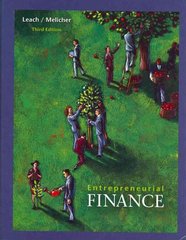Answered step by step
Verified Expert Solution
Question
1 Approved Answer
Hello, I have a few practice problems that are due on Sunday. I attempted question 1 part A and put my answers in BOLD that
Hello,
I have a few practice problems that are due on Sunday. I attempted question 1 part A and put my answers in BOLD that I felt were correct. I am confused on the rest of practice questions. Could you please assist? I have attached the problem in a word document. Thank you.
 Practice problems You are given the following information concerning several money market funds: Money Market Fund Return in Excess of the Treasury Bill Rate Beta A 12.4% 1.14 B 13.2% 1.22 C 11.4% 0.90 D 9.8% 0.76 E 12.6% 0.95 During the time period the Standard & Poor's stock index exceeded the Treasury bill rate by 10.5 % (i.e., rm - rf = 10.5%) a. Rank the performance of each fund without adjusting for risk and adjusting for risk using the Treynor index. Which, if any, outperformed the market? (Remember, the beta of the market is 1.0). Funds: A - 12.4/1.14 =10.88 B - 13.2/1.22 = 10.82 C - 11.4/0.90 = 12.67 D - 9.8/0.76 = 12.89 E - 12.6/.095 = 13.26 On a risk-adjusted basis the ranking is E, D, C, A, B. Fund B had the largest absolute return, but on a risk-adjusted basis, it was the worst performer. b. The analysis is part (a) assume each fund is sufficiently diversified so that the appropriate measure of risk is the beta coefficient. Suppose, however, this assumption does not hold and the standard deviation of each fund's return was as follows: Money Market Fund Standard Deviation of Return A 0.045 (= 4.5%) B 0.031 C 0.010 D 0.014 E 0.035 Thus, Fund A earned a return of 12.4%, but approximately 68% of the time this return has ranged from 7.9% to 16.9%. The standard deviation of the market return is 0.01 (i.e., 1 %), so 68 % of the time, the return on the market has ranged from 9.5 to 11.5%. Rank the funds using this alternative measure of risk. Which, if any outperformed the market on a risk-adjusted basis? *Note: The Treynor Performance Index is an alternative measure for portfolio evaluation. Ti = Rp (realized return on the portfolio) - Rf (the risk-free rate) / b (Portfolio beta, the measure of systematic risk) Thus, if the portfolio manager X achieved a return of 15 percent when the risk-free rate was 7 percent the the portfolio's beta was 1.1, the Treynor Index is Ti = 0.15-0.07/1.1 = 0.0727 If portfolio manager Y achieved a return of 13.5 percent with a beta of 0.8, the Treynor Index is Ti = 0.135 - 0.07 /0.8 = 0.08125 This indicates that portfolio manager Y outperformed portfolio manager X on a riskadjusted basis. 2
Practice problems You are given the following information concerning several money market funds: Money Market Fund Return in Excess of the Treasury Bill Rate Beta A 12.4% 1.14 B 13.2% 1.22 C 11.4% 0.90 D 9.8% 0.76 E 12.6% 0.95 During the time period the Standard & Poor's stock index exceeded the Treasury bill rate by 10.5 % (i.e., rm - rf = 10.5%) a. Rank the performance of each fund without adjusting for risk and adjusting for risk using the Treynor index. Which, if any, outperformed the market? (Remember, the beta of the market is 1.0). Funds: A - 12.4/1.14 =10.88 B - 13.2/1.22 = 10.82 C - 11.4/0.90 = 12.67 D - 9.8/0.76 = 12.89 E - 12.6/.095 = 13.26 On a risk-adjusted basis the ranking is E, D, C, A, B. Fund B had the largest absolute return, but on a risk-adjusted basis, it was the worst performer. b. The analysis is part (a) assume each fund is sufficiently diversified so that the appropriate measure of risk is the beta coefficient. Suppose, however, this assumption does not hold and the standard deviation of each fund's return was as follows: Money Market Fund Standard Deviation of Return A 0.045 (= 4.5%) B 0.031 C 0.010 D 0.014 E 0.035 Thus, Fund A earned a return of 12.4%, but approximately 68% of the time this return has ranged from 7.9% to 16.9%. The standard deviation of the market return is 0.01 (i.e., 1 %), so 68 % of the time, the return on the market has ranged from 9.5 to 11.5%. Rank the funds using this alternative measure of risk. Which, if any outperformed the market on a risk-adjusted basis? *Note: The Treynor Performance Index is an alternative measure for portfolio evaluation. Ti = Rp (realized return on the portfolio) - Rf (the risk-free rate) / b (Portfolio beta, the measure of systematic risk) Thus, if the portfolio manager X achieved a return of 15 percent when the risk-free rate was 7 percent the the portfolio's beta was 1.1, the Treynor Index is Ti = 0.15-0.07/1.1 = 0.0727 If portfolio manager Y achieved a return of 13.5 percent with a beta of 0.8, the Treynor Index is Ti = 0.135 - 0.07 /0.8 = 0.08125 This indicates that portfolio manager Y outperformed portfolio manager X on a riskadjusted basis. 2 Step by Step Solution
There are 3 Steps involved in it
Step: 1

Get Instant Access to Expert-Tailored Solutions
See step-by-step solutions with expert insights and AI powered tools for academic success
Step: 2

Step: 3

Ace Your Homework with AI
Get the answers you need in no time with our AI-driven, step-by-step assistance
Get Started


